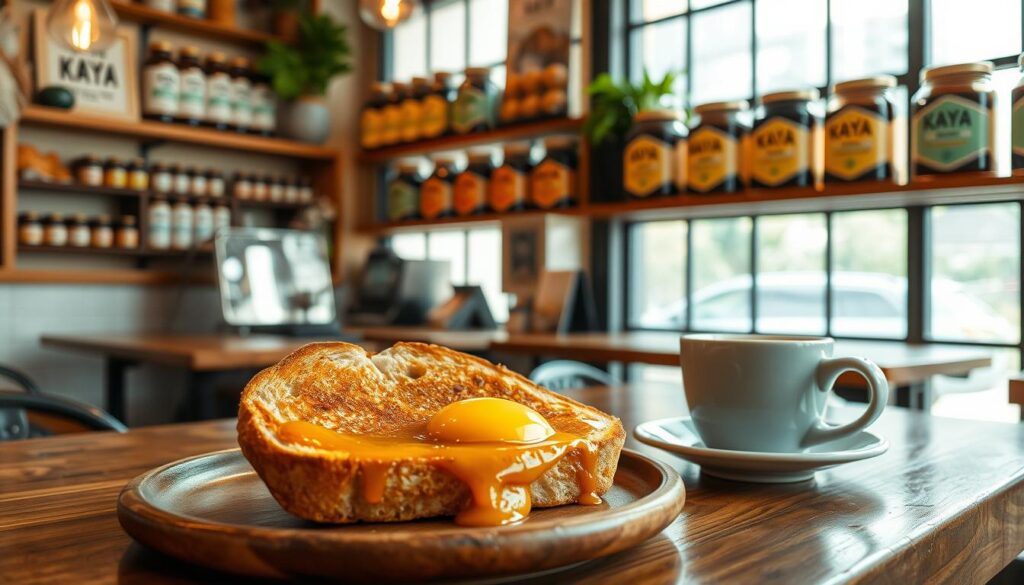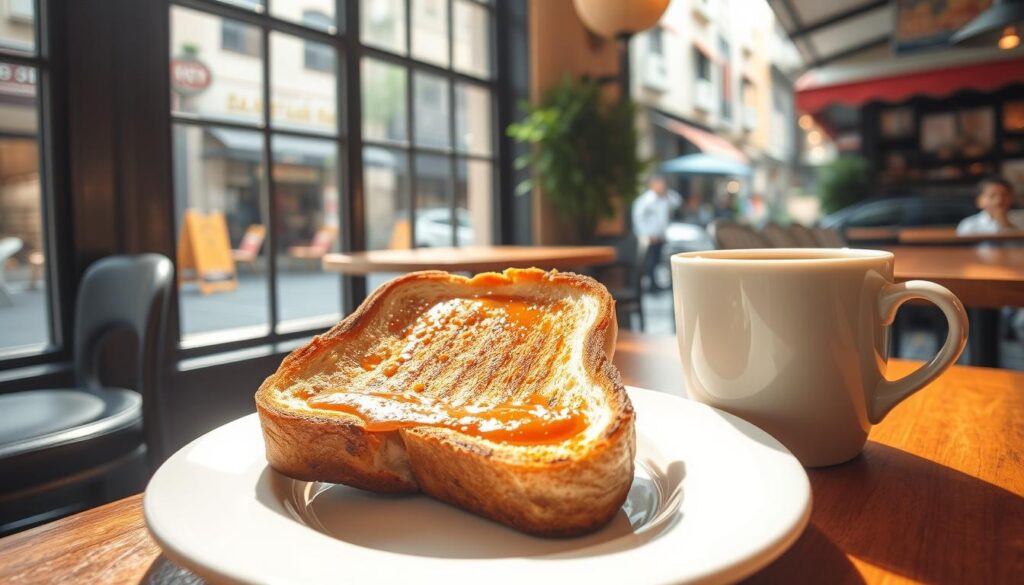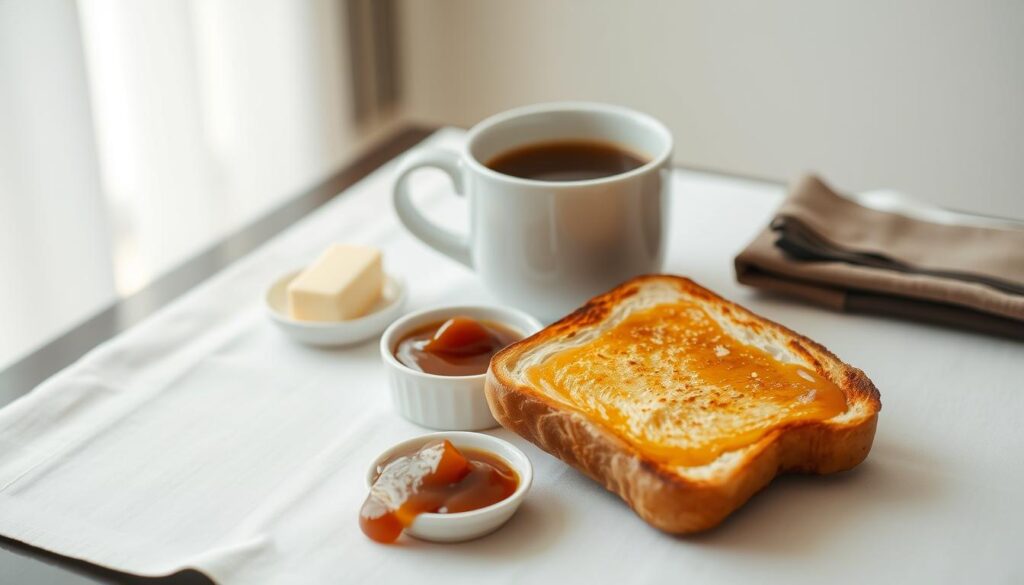Few dishes capture the essence of Singapore’s food culture like the iconic toast paired with a rich, fragrant spread. This breakfast staple has deep Hainanese roots, blending British colonial influences with local flavors. The golden-brown slices, crisp on the outside and soft inside, make every bite memorable.
At the heart of this dish lies a creamy coconut-egg concoction, infused with aromatic pandan leaves. The balance of sweetness and caramelized richness defines its quality. Traditionally, it’s served alongside soft-boiled eggs and a cup of strong local coffee, creating a perfect morning ritual.
From heritage cafes to modern twists, this treat remains a must-try for anyone visiting or living in the city. Whether enjoyed at a humble hawker stall or a chic café, its comforting taste connects generations.
Key Takeaways
- A signature morning meal with historical Hainanese influences
- Features a smooth coconut-egg spread flavored with pandan
- Often paired with soft-boiled eggs and traditional coffee
- Available in both classic and contemporary variations
- Discover top spots for authentic flavors at trusted local eateries
Introduction to Singapore’s Beloved Kaya Toast
British colonialism and Hainanese ingenuity birthed a national treasure. This iconic breakfast emerged in 1920s kopitiams, where immigrants fused toasted bread with coconut jam. Today, it’s a UNESCO-recognized symbol of hawker culture.
The History and Cultural Significance of Kaya Toast
Hainanese cooks adapted British tea-time snacks using local ingredients. Pandan leaves and caramelized palm sugar transformed simple spreads into kaya. The dish became a staple in coffee shops, paired with coffee and soft-boiled eggs.
National Geographic once sparked debate by calling it “unremarkable”—a claim locals fiercely disputed. For Singaporeans, each bite carries generations of tradition.
What Makes a Great Kaya Jam?
The best versions balance creamy coconut milk and rich egg yolks in a 3:1 ratio. Pandan adds fragrance, while slow cooking ensures silky texture. Graininess means rushed preparation.
| Type | Key Features | Best Paired With |
|---|---|---|
| Green Kaya | Pandan-infused, vibrant color | Charcoal toast |
| Brown Kaya | Pandan-free, deeper caramel notes | Buttery buns |
Explore classic sets or try modern twists like croissant cubes. Whether brown or green, this singaporean breakfast unites flavor and history.
Traditional Kaya Toast Spots You Can’t Miss
Step into Singapore’s rich culinary history with these legendary spots serving unforgettable toast. Each café offers a distinct take on texture and flavor, from smoky charcoal grills to wafer-thin crisps.

Heap Seng Leong: A Nostalgic Charcoal-Grilled Experience
Since the 1970s, this coffee shop has perfected thick, charcoal-grilled bread. Slabs of cold butter melt into the warm slices, paired with a unique butter coffee. The $3.60 set feels like a trip back in time.
Ya Kun Kaya Toast: The Household Name Since 1944
With 80+ outlets, Ya Kun stays true to its original pandan-infused recipe. Their toast is famously thin and crisp, offering a lighter bite. Locals swear by the classic set with soft-boiled eggs.
Chin Mee Chin Confectionery: Heritage Flavors on East Coast Road
This 1920s-style gem revived its crispy buns ($2.20) under new management. Alfresco seating adds charm to the experience. Don’t miss their steamed bread variations for a twist on tradition.
Whether you crave thick, thin, or bun-based toast, these spots deliver authenticity. From Heap Seng Leong’s smoky depth to Chin Mee Chin’s Instagrammable vibe, each bite tells a story.
Underrated Gems for the Best Kaya Jam in Singapore
Beyond the well-known chains, Singapore hides pockets of culinary magic where traditional flavors shine. These spots may lack flashy signs, but their toast and kaya combinations rival the classics. From charcoal-grilled bites to secret family recipes, here’s where to find unforgettable tastes.

Sen Yen Charcoal Traditional Toast: Hidden Hawker Stall Delight
Tucked in a bustling hawker center, Sen Yen’s $0.70 slices are a steal. Their French toast gets a smoky kiss from charcoal, paired with pandan-infused kaya that’s neither too sweet nor faint. The baguette’s crisp exterior gives way to a fluffy center—a modern twist on tradition.
Ah Seng (Hai Nam) Coffee: A Mother-Son Legacy
At Maxwell Food Centre, Ah Seng’s green kaya has sweetened mornings for 50 years. The ultra-rich coconut blend crowns eggy French toast, best enjoyed with their potent coffee. Regulars swear by the mother-son duo’s unwavering consistency.
Killiney Kopitiam: Affordable and Classic
With $6 sets, Killiney delivers nostalgia without the price tag. Their egg-flavored kaya leans savory, balanced by soft-boiled eggs and thick coffee. The 1940s vibe makes it a favorite for budget-conscious foodies.
- Sweetness scale: Ah Seng (high) → Sen Yen (medium) → Killiney (mild)
- Accessibility: Killiney’s chains are everywhere, while Sen Yen and Ah Seng reward the adventurous.
- Must-try: Sen Yen’s baguette, Ah Seng’s French toast, Killiney’s value sets.
Whether you’re after innovation, heritage, or wallet-friendly breakfast, these spots prove greatness doesn’t need fame.
Modern Twists on Kaya Toast
Modern cafés are reimagining traditional breakfast staples with bold twists. Chefs fuse heritage flavors with artisanal techniques, creating Instagram-worthy plates that honor the past while tasting fresh. Whether you crave flaky pastries or rustic sourdough, these spots deliver innovation.
![]()
Keong Saik Bakery: Kaya Toast Croissant Cube
This hip spot turns bread into art with its $8 croissant cube. Layers of buttery pastry hide a mocha ganache core, topped with kaya butter for sweet-savory contrast. The crisp exterior shatters to reveal a molten center—perfect with a cup of single-origin brew.
Homeground Coffee Roasters: The “Atas” Kaya Toast
At $9.50, this dining experience features brioche brushed with French butter. Sous vide eggs add luxury, while house-made pandan spread keeps it grounded. Third-wave coffee pairings like Gesha pour-overs elevate the meal.
Micro Bakery: Sourdough Meets Kaya
Gluten-free diners rejoice—their 48-hour fermented loaf offers chewiness without compromise. Sea salt flakes cut through the richness of kaya butter, creating balanced bites. The $7 set includes a cold brew for a complete singaporean breakfast.
- Texture showdown: Croissant (flaky) vs brioche (soft) vs sourdough (chewy)
- Price comparison: Keong Saik ($8) → Micro ($7) → Homeground ($9.50)
- Dietary notes: Micro offers gluten-free; Homeground uses premium dairy
From Keong Saik’s deconstructed cubes to Micro’s rustic approach, these modern takes prove tradition can taste new again.
Unique Kaya Toast Variations to Try
From crispy thin slices to fluffy buns, the city’s eateries reinvent this morning favorite in surprising ways. Whether you prefer nostalgic flavors or scenic dining, these spots deliver unforgettable textures.
Tong Ah Eating House: Crispy Thin Toast and French Toast
Since 1939, this shop on Beach Road has perfected wafer-thin slices ($5.40). Their secret? Double-toasting for extra crunch. The French version adds eggy richness, balanced by homemade kaya butter.
Slow Bakes: Scenic Kaya Toast With a View
Overlooking Yishun Pond, Slow Bakes’ $2.50 brioche brings luxury to breakfast. Thick cuts soak up pandan-infused spread while maintaining chewiness. Perfect for Instagram shots with lakeside views.
YY Kafei Dian: Pillowy Buns and Rich Kaya
Their $1.60 steamed buns feel like clouds with dense coconut filling. The kopi set includes runny eggs—ideal for dipping. Vegetarians love the egg-free kaya option.
- Texture spectrum: Tong Ah (crispy) → Slow Bakes (buttery) → YY Kafei Dian (airy)
- Budget picks: YY Kafei Dian wins for value, while Slow Bakes offers ambiance.
- Must-try: Tong Ah’s signature crisp, Slow Bakes’ photo-worthy plates.
Kaya Toast Sets: The Perfect Breakfast Combo
A complete morning meal isn’t just about food—it’s a ritual that defines Singaporean mornings. The classic trio of crispy bread, rich spread, and aromatic coffee creates harmony in every bite. This dish transforms simple ingredients into something extraordinary.

Anatomy of a Classic Set
Traditional kaya toast sets follow a precise formula. Two golden slices sandwich cold butter and pandan-infused spread. On the side, soft-boiled eggs swim in porcelain cups, ready for dipping. A cup of kopi or tea completes the experience.
| Component | CBD Style | East Coast Style |
|---|---|---|
| Toast | Thin & crisp | Thick & fluffy |
| Eggs | Runny (3-min boil) | Custardy (4-min boil) |
| Beverage | Kopi-O kosong | Teh-C |
| Price Range | $5-$9 | $4-$7 |
Top Spots for Full Breakfast Experience
Heavenly Wang’s $5 special delivers exceptional value. Their signature spread pairs perfectly with charcoal-grilled bread. For travelers, Fun Toast’s airport sets include unique twists like soya chicken rice.
Master the eggs:
- Use room-temperature eggs for even cooking
- Steep in 80°C water for 3.5 minutes
- Add dark soy sauce and white pepper before stirring
Whether you prefer old-school kopitiams or modern cafés, these sets offer more than sustenance—they’re edible nostalgia.
Where to Buy Kaya Jam for Home Enjoyment
The perfect jar of kaya jam can turn your kitchen into a kopitiam-style breakfast spot. Whether you prefer convenience or homemade authenticity, Singapore offers delicious options to recreate this food tradition. From supermarket staples to small-batch artisans, here’s how to enjoy that iconic flavor anytime.
Top Bottled Kaya Brands
Ya Kun’s $8.90 pandan-infused spread (420g) dominates supermarket shelves with its balanced sweetness. Their pasteurized version lasts three months unopened but loses some aromatic depth compared to fresh batches.
For artisanal quality, Chin Mee Chin’s east coast shop sells limited jars with caramelized gula melaka notes. These small batches need refrigeration and last just four weeks—proof of their natural ingredients.
- Shelf life: Supermarket brands (3-6 months) vs artisanal (1 month)
- Texture tip: Stir pasteurized jam vigorously to restore silkiness
- Gift options: Look for festive gift boxes at airport duty-free stores
DIY Kaya Jam Like a Pro
Local chefs swear by fresh coconut milk and palm sugar for authentic flavor. “Low heat and constant stirring prevent graininess,” advises Mrs. Lim, a third-generation kopitiam owner. Her 45-minute stovetop method yields velvety results.
Perfect pairings for homemade kaya:
- Charcoal-grilled bread for smoky contrast
- Brioche for luxurious texture
- Wholegrain toast for health-conscious mornings
Add a slab of cold butter between warm toast slices for that classic kopitiam experience. With these tips, your homemade version might rival your favorite café’s.
Conclusion
This beloved morning ritual has journeyed from humble kopitiams to global brunch menus. The dish blends heritage with creativity, offering crispy toast or artisanal pastries. Whether you prefer smoky charcoal grills or flaky croissants, there’s a version for every palate.
Don’t miss the classic kaya toast sets with soft-boiled eggs and robust coffee. Modern twists like sourdough or brioche prove tradition can feel fresh. First-time visitors should start with Ya Kun or Heap Seng Leong for an authentic taste.
As this singaporean breakfast gains fame, it’s clear—simple ingredients create unforgettable flavors. Share your favorite spot or homemade twist below!


